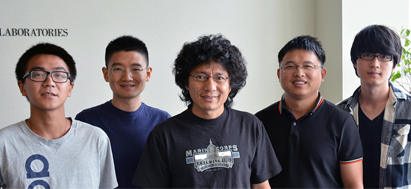New Method Makes Building 'One-Handed' Drugs Easier than Ever
Chemists at The Scripps Research Institute (TSRI) have invented a new technique for constructing one-handed or “chiral” drug molecules. The new method is already being adopted by pharmaceutical researchers.
“This new process provides an entirely new pathway for constructing one of the ‘cornerstones’ of chiral molecules, namely, beta-chiral centers, and should accelerate the development of chiral drugs,” said senior author Jin-Quan Yu, Frank and Bertha Hupp Professor in the Department of Chemistry at TSRI.

Authors of the new study include (left to right) Zhe Zhuang, Tao Liu, Jin-Quan Yu, Gang Chen and Yan-Qiao Chen. (Photo by Cindy Brauer.)
The new method, published in the September 2, 2016 issue of the journal Science, is a major addition to the molecule-construction toolkit.
Mirror Images
A molecule that is chiral is physically not symmetric; it thus has a “mirror image” form that looks different in the way that a right hand looks different from a left hand. Often only one of these two chiral forms has the desired drug properties—the other one may even cause unwanted side effects.
Most modern drugs therefore contain just one chiral form of the drug molecule. Achieving this isn’t always easy, though; there are relatively few useful reactions that yield single chiral forms rather than a roughly equal mix of both.
In the new study, the team tackled the problem of adding chiral asymmetry to a common organic structure in which, at one end, a carbon atom is attached to two hydrogen atoms via single bonds—a “beta methylene” in chemists’ parlance.
Selectively replacing just one of the two hydrogens with a new cluster of atoms (known as a functional group) would make the structure asymmetric and would enable the construction of beta-chiral centers in a wide variety of chiral drug molecules. However, chemists have not had an easy method for doing this—the standard textbook method, conjugate addition, requires the additional step of creating a double bond at the carbon.
Yu’s lab in recent years has helped pioneer a number of new strategies that can direct a palladium atom—whose properties make it an excellent bond-breaking catalyst in many contexts—to a precise location on an organic molecule, in order to rip apart a selected carbon-hydrogen bond. In this case, Yu’s team engineered a chiral catalyst that can direct a palladium atom to displace just one or the other hydrogen selectively on a beta methylene carbon atom to create asymmetry. The displacement in this case allows the hydrogen’s replacement by a variety of aryl groups—structures that are commonly used in drug molecules.
The catalyst structure includes two palladium-holding clusters of atoms called quinoline and NHAc groups. Such bidentate (literally: double-toothed) compounds normally have what is called a five-membered ring chelating structure, but in this case, a five-membered structure proved too rigid to accommodate the necessary reactions.
“In addition to the exquisite design of the quinoline and NHAc motifs, we ended up engineering a six-membered ring chelating structure, which is more flexible—that was surprising, but very important to our success,” said Gang Chen, a research associate in the Yu Laboratory who was first author of the paper.
Broad Applications
The new technique works well with two broad and relatively inexpensive classes of starting compounds, aliphatic amides and free carboxylic acids, providing efficient yields and very high ratios of the desired chiral form over the other.
In principle, the technique can be broadened even further. “We are now working to extend this reaction to other starting materials such as alkyl amines and alcohols,” Yu said. “We are also working on methods for replacing the carbon-hydrogen bond not just by aryls but by a much wider variety of nitrogen and oxygen-containing organic fragments.”
Through an ongoing research collaboration agreement with TSRI, the pharmaceutical company Bristol Myers-Squibb is already using the new method for making a chiral g-amino acid needed for the synthesis of a candidate drug.
In the fundamental study of how the new catalyst functions, Yu and his team collaborated with the University of California, Los Angeles (UCLA) laboratory of chemist Kendall N. Houk to develop a “stereomodel” of the catalyst and its interactions with the starting material. “This stereomodel should pave the way for further refinement of chiral catalysts,” said Yu.
Other authors of the paper, “Ligand-Accelerated Enantioselective Methylene C(sp3)–H Bond Activation,” were co-first author Wei Gong, Zhe Zhuang, Michal S. Andrä, Yan-Qiao Chen, and Tao Liu, all of TSRI at the time of the study; and Xin Hong and Yun-Fang Yang of the Houk Laboratory at UCLA.
The research was supported by funding from the National Institute for General Medical Sciences (grant 2R01GM084019).
Send comments to: press[at]scripps.edu













